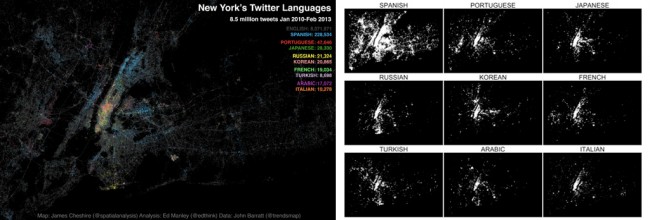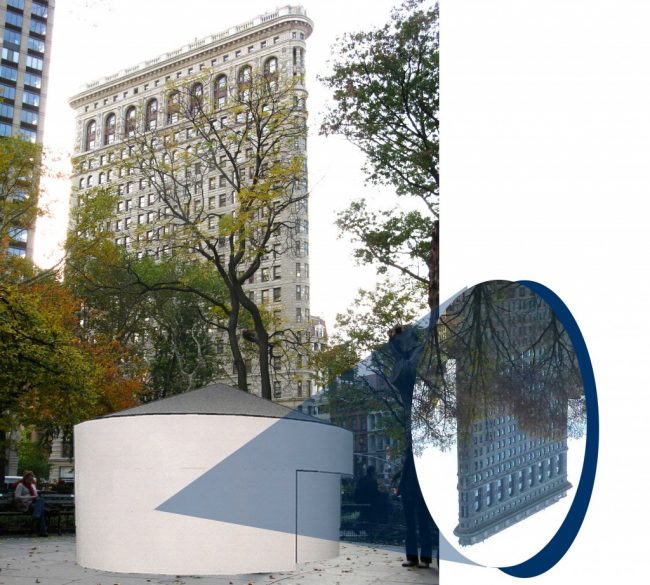
Celebrate ten years of Urban Omnibus and support ten more years of fresh, independent perspectives on citymaking with a donation today!
Celebrate ten years of Urban Omnibus and support ten more years of fresh, independent perspectives on citymaking with a donation today!
MADE IN NY
The Bloomberg administration continues its push to create a Silicon Alley that rivals Silicon Valley with the launch Thursday of Made in NY, a campaign to promote tech companies that complete at least 75% of their development in the city. In addition to new advertisements highlighting the achievements of the New York tech scene, the initiative includes the launch of a website that maps the companies of the burgeoning industry and provides additional information on job openings, shared workspace, coding classes, and training grants. The job map illustrates growing tech clusters beyond Manhattan in Brooklyn neighborhoods like DUMBO, the Brooklyn Navy Yard, and Downtown Brooklyn, which some politicians are hoping will become the next neighborhood to benefit from the industry’s expansion. Though some market analysts believe dwindling space in DUMBO and the isolation of the Brooklyn Navy Yard will inevitably make Downtown Brooklyn the third point in the borough’s Tech Triangle, barriers of inadequate infrastructure and desirable commercial space have so far stemmed the flow.
FUNDING CITY PARKS
In recent years, philanthropic contributions to some of New York’s most iconic parks have reached levels previously reserved for universities, hospitals, and cultural institutions — the Central Park Conservancy received $100 million last year from a single donor, believed to be the largest donation to a park in American history. Comparatively, the Flushing Meadows – Corona Park Conservancy, serving the largest park in Queens and far less affluent communities than Central Park, attracted a total of only $5,000 in donations last year. Although all city parks receive some measure of public funding for routine maintenance, high profile public spaces are increasingly relying on donors to fund improvements, programming, and additional upkeep through park conservancies, trusts, or alliances often credited with parks’ revivals following decades if neglect and divestment from the City. While many argue that using private money to improve public space is a city-wide good, the influx of funds into a few high profile parks concerns some parks advocates who worry it will result in decreased public funding for parks across the board, adversely affecting parks in low and middle income neighborhoods that are unable to raise much private money.

Composite map of tweets in ten languages across New York (L) and individual maps for nine languages (R) | Images via Spatial Analysis
TWITTER LANGUAGES
When geo-location, social media, and tweet-happy New Yorkers coalesce, the product can be a surprisingly illuminating picture of the cities linguistic makeup. Three English mappers plotted 8.5 million tweets on a map of New York, coding them by language, to showcase the overlapping as well as concentrated populations of speakers of 25 languages. See the interactive map here.
FIX-IT-FIRST
After announcing a new “Fix-it-First” initiative to address the nation’s dilapidated infrastructure in his State of the Union speech last week, President Obama further fleshed out a plan that seeks to minimize components needing Congressional approval and to capitalize on private investment in projects. Beyond the $50 million intended for highways, bridges, transit systems, and airports “most in need of repair,” Obama again called for the creation of a National Infrastructure Bank that could pool private and public funding sources for projects, some of which could come from the issuance of new “America Fast Forward” bonds. Transit advocates, although optimistic about the announcements, have voiced concern over the continued emphasis on road projects the plan will likely represent.
STATE OF THE BLOCK
Following Mayor Bloomberg’s State of the City address last week, The New York Times reached out to readers for their take on the state of their blocks. Generally less rosy than the Mayor’s take on his last twelve years, the featured responses range from enthusiasm about new restaurants, recycling bins, bike lanes, and the impending High Bridge redevelopment, to reminiscences of pre-Sandy life, complaints about those same restaurants and bike lanes, and the expected concerns about trash, traffic, gentrification, and affordability.
90 BY 50
A new report by the New York Chapter of the U.S. Green Building Chapter argues that New York City can cut 90% of its carbon emissions by 2050 using existing, relatively affordable technologies. The study focuses on reducing building energy consumption and improving transit at a total net cost of $20 billion after energy savings are taken into account. This Thursday, February 28th, the Urban Green Council has organized a discussion of the report, find more information at their website here.
NEW YORK BIOTOPES
Lena Steinkühler‘s video New York Biotopes imagines a New York inhabited by abstract plants that assimilate aspects of the city — subway seats, street lights, and turnstiles — and grow, adapting to the cities constraints while shaping the living environment in a “symbiotic coexistence.” Check out the beautiful, psychedelic piece above.
BRONX BOUTIQUES
Common perceptions of the Bronx tend to involve images of poverty and neglect, and the borough has yet to see the same level of revitalization efforts that parts of Brooklyn and Queens have experienced. But in a bid to recast the image of the borough and turn around its languishing economy, community groups and elected officials are supporting the redevelopment of some historic properties into hotels catering to tourists looking for luxury but priced out of Manhattan, including the Andrew Freedman Home and the Bronx Opera House. While some residents view the juxtaposition of such development with surrounding poverty as evidence of misplaced priorities and impending gentrification, proponents see a resource to bring people to the Bronx and job opportunities for its residents.
CITY CHANGERS
Recognizing the potential and necessity for cities to drive the changes needed for a sustainable future, UN-HABITAT, the United Nations agency dedicated to promoting socially and environmentally sustainable towns and cities, has launched the “I’m a City Changer” campaign to collect and share initiatives that improve our cities. View initiatives from around the world and add your own on their website.
SANDY UPDATES
Through Manhattan’s Financial District has rebounded reasonably well from flooding that crippled many buildings’ operations for weeks (and in some cases months), some other neighborhoods haven’t fared as well. In Brooklyn, residents and businesses in hard-hit Red Hook are wondering if their neighbors and customers who left following the flooding will return. One resident notes the loneliness of a block that seems to have lost half of its residents, and several businesses, including the popular Red Hook Lobster Pound, are having difficulty finding enough workers.
New York City’s Department of Housing Preservation and Development (HPD) announced a new program to allocate 25% of units in newly opened developments to low- and middle-income families who lost their homes in the storm. Tenants must still meet the income requirements for the developments but will receive preference over other families on HPD’s housing lottery roles. The first development to be affected by the new program is set to open this summer in Coney Island.
New legislation will be introduced in the City Council next week to regulate the process of elevating houses to protect them from flooding, a proposal Staten Island City Councilmen Vincent Ignizio says was informed by the problems New Orleans residents faced when rebuilding after Hurricane Katrina. The legislation, if passed, would mandate oversight of such projects by the Department of Buildings and an approved architect or engineer.
This week the NYC Department of Parks and Recreation released its plans for the reconstruction of Rockaway’s beaches, with a goal of May 24th for a partial public reopening. The plans do not include new boardwalk designs residents had hoped for, but do include renderings for new restrooms, food stations, and kayak and bike rentals, causing some residents — who were not aware these facilities were planned — to ask why department officials failed to consult them.
Crain’s this week looks at one significant obstacle that stopped hundreds of architects and engineers from volunteering their expertise in recovery efforts immediately following Sandy: fear of litigation. After 9/11, many architects, engineers, and construction experts that mobilized and volunteered in the quick response after the disaster were later sued, setting a damaging precedent for expertise in emergency response. A new bill introduced in the New York State Assembly will grant them Good Samaritan legal protections, already provided in 24 states.

A mock-up of the Topsy Turvy, a camera obscura installation in Madison Square Park | Image via Madison Square Park Conservancy
EVENTS AND STUFF TO DO
TOPSY TURVY
Mad. Sq. Art — the contemporary art program of the Madison Square Park Conservancy — will host Topsy Turvy: A Camera Obscura Installation, a piece commissioned for the park that offers a “new view of New York City landscape via one of the world’s oldest moving image devices.” Visitors can enter the 10′ x 10′ structure which uses the physical properties of light in a centuries old technique to capture images of the surrounding park.
MAS’ VISION FOR EAST MIDTOWN
Join the Municipal Art Society (MAS) on February 26th for the release of its report on the future of East Midtown, including their recommendations and research results surrounding the rezoning of the neighborhood. A panel discussion about the report will be followed by a wine and cheese reception and the MAS’s annual meeting, discussing the organization’s efforts “to ensure a livable and resilient New York City” and a report on the latest post-Sandy work. Register for the event here.
ARCHITECTURE ON SCREEN FESTIVAL
Next week, the Center for Architecture will host the fourth annual Architecture on Screen Festival, featuring nine international films selected from the 2012 Montreal International Festival of Films on Art. Screenings begin at 2:30pm on Friday, March 1st, and 1:00pm on Saturday, March 2nd.
The Roundup keeps you up to date with topics we’ve featured and other things we think are worth knowing about.
The views expressed here are those of the authors only and do not reflect the position of The Architectural League of New York.